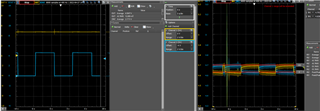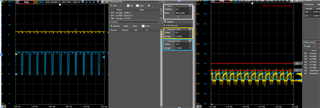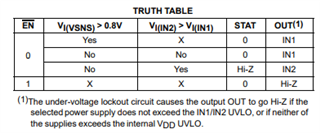Other Parts Discussed in Thread: LM66100, , TPS2113A, TPS2115, TPS2113, TPS2116
Hi,
Our current application design requires two similar sets of 4.2V batteries as primary and secondary power sources.
Previously, we were first considering the LM66100 but, as reported, it does not perform well when we have similar levels for the input voltages considering a seamless transition:
(https://e2e.ti.com/support/power-management-group/power-management/f/power-management-forum/1066260/lm66100-auto-switching-power-mux-with-similar-voltage-input-levels)
Then, we have been trying some ICs from the TPS21xx family as initially suggested.
Considering components availability, the TPS2115A (D0 D1 and STAT pins) was selected for testing and the next results were obtained for the following configurations
Left side Vout (yellow) and STAT(blue) pins. Right side VIN1 and VIN2 ( initial voltage of 4.8V):
Cin1 = Cin2 = 47uF + 10uF, Rload = 100Ohm Cload = 10uF.
Cin1 = Cin2 = 47uF + 10uF, Rload = 33Ohm Cload = 10uF.
Cin1 = Cin2 = 47uF + 10uF, Rload = 20Ohm Cload = 10uF.

Result: Vout follows the highest VIN input when VIN1 >> VIN2 or VIN2 << VIN1 ( an output switchover voltage droop will still be visible).
However, when both inputs are configured for a similar value, There’s a drop in the selected input, and the deselected input returns to its nominal value, (again the highest voltage). As shown, this causes an input oscillation (around 100mV) during the multiple selection. It might match the described comparator's hysteresis interval (30- 57(typ) - 65 mV).
- Is there any suggestion on how to prevent this behavior and create a more stable output voltage?
- Is this device designed for an highest difference between inputs?
- Should the design approach be changed and only use the secondary power supply when the primary input reaches a pre-defined low voltage value ( i.e. using a resistor divider with the VSNS in version TPS2113A)?
- The D0 and D1 (TTL pins) on the TPS2115 version will not work as a comparator (similar to the VSNS), right?
- If using the pre defined voltage value, after the primary voltage source has switched to the secondary input source, will the device oscillate between both inputs when this secondary has the same voltage level as the primary source?
Thank you for your attention.




